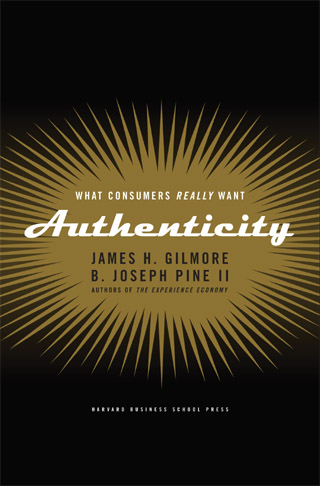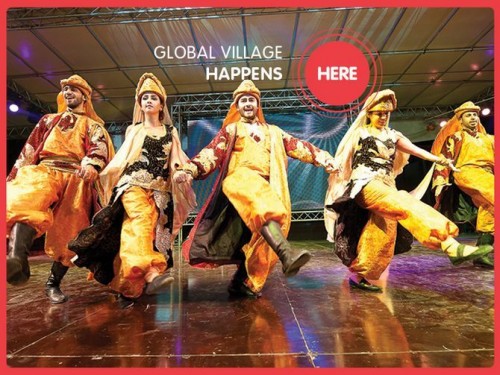
 We have talked quite a bit about authenticity of late, mostly in terms of its cultural expressions and frustrations, from Nicki Minaj and Anne Hathaway, to its incarnations in the political spheres of conversation, to the hipster modicums toward/against consumerism and the “narcissism of small differences“. We’ve talked about how its been brought into hyperdrive by way of technology.
We have talked quite a bit about authenticity of late, mostly in terms of its cultural expressions and frustrations, from Nicki Minaj and Anne Hathaway, to its incarnations in the political spheres of conversation, to the hipster modicums toward/against consumerism and the “narcissism of small differences“. We’ve talked about how its been brought into hyperdrive by way of technology.
But we haven’t really covered authenticity from the business side of things. Not like James Gilmore and B. Joseph Pine II do in Authenticity: What Consumers Really Want. From the Harvard Business School Press, Gilmore and Pine talk about the changing landscape of business practice, how we have left the “goods and services economy” and entered the age of the “experience economy.” In short, businesses have begun to operate on the ante-upped principles and values of Authenticity rather than just Quality or Affordability or Availability. People don’t just want to describe their products or services as good or premium or best-bang-for-your-buck; people want vintage, real, genuine, original, heirloom. On the other hand, products/services/experiences collecting dust are the ones described as “fake, contrived, disingenuous, phony.” Here is how Gilmore/Pine describe it:
Just as the rise of services helped to establish quality as a field worthy of deliberate management attention, the rise of experiences calls for a new arena of management expertise. Organizations today must learn to understand, manage, and excel at rendering authenticity. Indeed, “rendering authenticity” should one day roll trippingly off the tongue as easily as “controlling costs” and “improving quality,” for rendering is precisely the right term for what’s involved. To be blunt: your business offerings must get real. When consumers want what’s real, the management of the customer perception of authenticity becomes the primary new source of competitive advantage–the new business imperative.
Gilmore/Pine are quick to say that “rendering authenticity” means little to nothing if products are affordable and perform as they should. If they do, though, the product is rendered authentic when it is “purchased on the basis of conforming to self-image.” Business now functions on the manipulation and presentation of identity–the product has an identity, and the product identifies the consumer. I think quickly to Domino’s resurgence into the pizza delivery top two, something that happened from 2009’s “Turnaround” campaign. Just watch the video below and you’ll get an idea of what they’re talking about. The product is given a back-to-the-basics cure, which is all fine and good, but the underlying manifesto is the confession: we’ve lost our heritage, we’ve lost our Domi-Nick’s, 50-year-old, two-brothers-and-a-Volkswagen identity, and we are sorry. We are going to get back there. This was the imperative met: create the perception of getting real.
[youtube=http://www.youtube.com/watch?v=AH5R56jILag&w=600]
I also think of the magazine Garden & Gun. A masterful publication in this regard: it creates an aesthetic of the American South that can be picked up by clubhouse matrons as much as it can their hipster-leaning debutantes. It allows the former the safe thrill of being on the inside of a new wave of the New South, while allowing the latter the identifying pride of being of the traditional Southern, pop-culture cognoscenti.
These so-often contrived and sometimes gratuitous experiences force us to consider: What is a real experience and what is not? What is really necessary and what is not? Why do we so readily hire outside companies–who are in it for a profit–to fabricate such experiences? We understandably question the authenticity of paid-for experiences as we participate more and more in the Experience Economy. Yet more people are buying not only travel and entertainment experiences but matchmaking, wedding, birthing, parenting, celebrating, and even death-and-dying experiences. Why? People may say they want such personal experiences to remain untouched by commerce, but if consumers want more efficiency (for cost reasons), more excellence (for quality reasons), or more sincerity (for authenticity reasons), then buying expertise and assistance often increase the real value of such life moments…In losing degrees of self-sufficiency, and perhaps innocence, people will seek something in return–specifically, a self more aligned with who one wants to be, a lived-in self conforming more and one’s own self-image.
Gilmore and Pine are not denying that this a manufactured affair. In this time, they seem to be saying, we buy to be. In framing the “landscape” of authenticity, they survey the course of economic offerings–commodities, goods, services, experiences, and last, transformations–and describe how businesses have appealed to each of these offerings to hopeful consumers. In other words, there are plenty of ways to “show real.” Two of the most compelling are the ones given for the experience economy and the transformational economy:
Experiences: Referential authenticity. People tend to perceive as authentic that which refers to some other context, drawing inspiration from human history, and tapping into our shared memories and longings; not derivative or trivial. These iconic experiences mentioned–drinking beer in England, the Chinese tea ceremony, and so forth–all exhibit referential authenticity, drawing their inspiration from the rituals of long-standing cultures. Further, whenever you read a review that says a novel or movie is “real” or “authentic” it is because the novelist or director renders their work as referentially real, a verisimilitude of real life.
Transformations: Influential authenticity. People tend to perceive as authentic that which exerts influence on other entities, calling human beings to a higher goal and providing a foretaste of a better way; not inconsequential or without meaning. The wave of interest in sustainability in building construction–for homes, offices, and factories–stems from this genre of authenticity, as do fair trade practices and the like. Even Hard Rock Cafe’s tagline, “Save the Planet,” seeks to render the restaurant venue more real via influential authenticity.
The verb used most accurately here is “render.” To provide, to cast or coat, to submit or make available, to re-present. In a cultural and economic exchange that has all to do with what is real and what is fake–we are all buyers buying selves. And it’s worth asking, “What is rendering me?” Certainly “They” are, but also, I am, with the products I buy and my affiliate grocery store and wish lists. But then there’s the problem of something deeper, of what’s not rendered; the self I do not know how to name–the self that I continue to try to scrawl out with some, any kind of “authentic” investiture.

COMMENTS
7 responses to “To Render Authenticity: The New Business Imperative”
Leave a Reply














Originally, I loved Garden and Gun and I still take it, but now I read it as a parody. It is like Portlandia in print for those below the Mason Dixon,or those who want to be. It just tries to hard. That’s the problem with store-bought authenticity — it just wears you out. Plus, who needs G&G when you can get SEC football, Walker Percy, and religion on mbird.com?
I think for me the problem is that even after I accept that the quest for authenticity is futile, I still have to choose clothes, food, a place to live, things to do, ways to spend my day. And I’d like for those choices to reflect an ethos consist with my identity in Christ even though intellectually I realize that is impossible, if not ironic. In other words, I’d like some way to render that self which is by definition not capable of being rendered in the terms and tools of this world – my self in Christ. While I know it can’t be done, it does not help to answer the pressing question of, then what do we do instead? Right now? The truthful and powerful answer of nothing, surrender, accept does little to inform the practical consumer choices we make every day. Nor does a commitment to organic, local, fair-trade, etc. solve this problem, even if it presents a more cohesive ethos. Thoughts?
Great points, Caroline. Maybe in a way the practical choices of organically grown, humanely raised, and fair-trade products become free and happy choices when they are made because we think maybe it’s some tiny gesture toward what the world should look like, even though we know we are still the same frauds we always were. When I do those things in order to achieve some “authenticity”, then the Harvard Business School has me where they want me…in their own “authentic” fantasy world, created for the sole purpose of selling s—.
Caroline, thank you for your insights. I feel very much the same way, and it seems that what you are getting at is, on a more micro and practical level, is the “already, not yet” or “justified, yet a sinner” tension that we live in now. We desire to have Christ fill all our needs, yet we do still buy clothes based on many internal and external forces that we can name (i.e. our socioeconomic status, how we wish to be seen). We are in fact, still human. It seems that for any progress to be made in this life, we must first accept our reality. Frustration, guilt and discouragement don’t seem to be much help, but can be the pathway to this “surrender of sorts.” In short, I share your confusion with what to do when I finish typing this post.
James Gilmore wrote a wonderful tribute to Robert Farrar Capon:
http://www.outofur.com/archives/2013/09/robert_farrar_c.html
(Yes, it is the same James Gilmore – he is on the Board of The White Horse Inn).